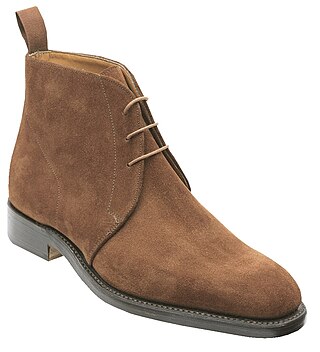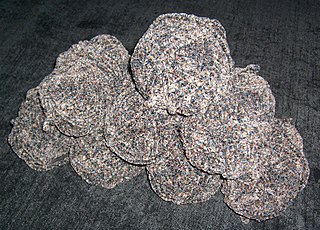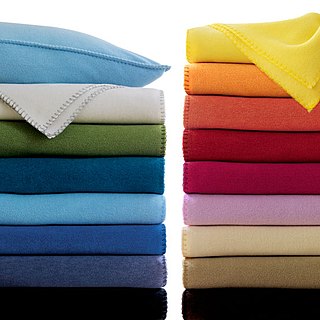Related Research Articles

Textile is an umbrella term that includes various fiber-based materials, including fibers, yarns, filaments, threads, different fabric types, etc. At first, the word "textiles" only referred to woven fabrics. However, weaving is not the only manufacturing method, and many other methods were later developed to form textile structures based on their intended use. Knitting and non-woven are other popular types of fabric manufacturing. In the contemporary world, textiles satisfy the material needs for versatile applications, from simple daily clothing to bulletproof jackets, spacesuits, and doctor's gowns.

Yarn is a long continuous length of interlocked fibres, used in sewing, crocheting, knitting, weaving, embroidery, ropemaking, and the production of textiles. Thread is a type of yarn intended for sewing by hand or machine. Modern manufactured sewing threads may be finished with wax or other lubricants to withstand the stresses involved in sewing. Embroidery threads are yarns specifically designed for needlework. Yarn can be made of a number of natural or synthetic materials, and comes in a variety of colors and thicknesses. Although yarn may be dyed different colours, most yarns are solid coloured with a uniform hue.

Suede is a type of leather with a fuzzy, napped finish, commonly used for jackets, shoes, fabrics, purses, furniture, and other items. The term comes from the French gants de Suède, which literally means "gloves from Sweden". The term was first used by The Oxford English Dictionary in 1884.
Lawn cloth or lawn is a fine plain weave textile, made with fine combed cotton. Terms also used include batiste and nainsook. Originally the name applied to plain weave linen, and linen lawn is also called "handkerchief linen". The term lawn is also used in the textile industry to refer to a type of starched crisp finish given to a cloth product. The finish can be applied to a variety of fine fabrics, prints or plain.
A modacrylic is a synthetic copolymer. Modacrylics are soft, strong, resilient and dimensionally stable. They can be easily dyed, show good press and shape retention, and are quick to dry. They have outstanding resistance to chemicals and solvents, are not attacked by moths or mildew, and are nonallergenic. Among their uses are in apparel linings, furlike outerwear, paint-roller covers, scatter rugs, carpets, and work clothing and as hair in wigs.

A shawl is a simple item of clothing, loosely worn over the shoulders, upper body and arms, and sometimes also over the head. It is usually a rectangular or square piece of cloth, which is often folded to make a triangle, but can also be triangular in shape. Other shapes include oblong shawls. It is associated with the inhabitants of northern Indian subcontinent—particularly Kashmir and Punjab—and Central Asia, but can be found in many other parts of the world.

Fake fur, also called faux fur, is a pile fabric engineered to have the appearance and warmth of animal fur.

Acrylic fibers are synthetic fibers made from a polymer (polyacrylonitrile) with an average molecular weight of ~100,000, about 1900 monomer units. For a fiber to be called "acrylic" in the US, the polymer must contain at least 85% acrylonitrile monomer. Typical comonomers are vinyl acetate or methyl acrylate. DuPont created the first acrylic fibers in 1941 and trademarked them under the name Orlon. It was first developed in the mid-1940s but was not produced in large quantities until the 1950s. Strong and warm acrylic fiber is often used for sweaters and tracksuits and as linings for boots and gloves, as well as in furnishing fabrics and carpets. It is manufactured as a filament, then cut into short staple lengths similar to wool hairs, and spun into yarn.

Chenille is a type of yarn, or fabric made from it. Chenille is the French word for caterpillar whose fur the yarn is supposed to resemble.

Thinsulate is a brand of synthetic fiber thermal insulation used in clothing. The word is a portmanteau of the words thin and insulate, trademarked by 3M. The material is made by the 3M Corporation and was first sold in 1979. It was originally marketed as an inexpensive alternative to down; at the time, 3M claimed it was twice as warm as an equivalent amount of any natural material.

Boiled wool is a type of fabric primarily used in creating berets, scarves, vests, cardigans, coats, and jackets. To create this fabric, knit wool or wool-blend fabrics are agitated with hot water in a process called fulling. This process shrinks the fabric and results in a dense felted fabric that resists fraying and further shrinkage.

Polar fleece is a soft napped insulating fabric made from polyester.
Collins & Aikman Corporation was an automotive manufacturer of cockpit modules and automotive floor and acoustic systems and a supplier of instrument panels, automotive fabric, plastic based trim and convertible top systems. The Company's operations spanned 15 countries, incorporating about 120 facilities and approximately 25,000 employees. It entered Chapter 11 bankruptcy on May 17, 2005 and went out of business on October 12, 2007.

Warp knitting is defined as a loop-forming process in which the yarn is fed into the knitting zone, parallel to the fabric selvage. It forms vertical loops in one course and then moves diagonally to knit the next course. Thus the yarns zigzag from side to side along the length of the fabric. Each stitch in a course is made by many different yarns. Each stitch in one wale is made by several different yarns.
The manufacture of textiles is one of the oldest of human technologies. To make textiles, the first requirement is a source of fiber from which a yarn can be made, primarily by spinning. The yarn is processed by knitting or weaving, which turns yarn into cloth. The machine used for weaving is the loom. For decoration, the process of colouring yarn or the finished material is dyeing. For more information of the various steps, see textile manufacturing.
Ventile, is a registered trademark used to brand a special high-quality woven cotton fabric first developed by scientists at the Shirley Institute in Manchester, England. Originally created to overcome a shortage of flax used for fire hoses and water buckets, its properties were also found to be ideal for pilots' immersion suits.

Novelty yarns include a wide variety of yarns made with unusual features, structure or fiber composition such as slubs, inclusions, metallic or synthetic fibers, laddering and varying thickness introduced during production. Some linens, wools to be woven into tweed, and the uneven filaments of some types of silk are allowed to retain their normal irregularities, producing the characteristic uneven surface of the finished fabric. Man-made fibres, which can be modified during production, are especially adaptable for special effects such as crimping and texturizing.

Alpaca fleece is the natural fiber harvested from an alpaca. There are two different types of alpaca fleece. The most common fleece type comes from a Huacaya. Huacaya fiber grows and looks similar to sheep wool in that the animal looks "fluffy". The second type of alpaca is Suri and makes up less than 10% of the South American alpaca population. Suri fiber is more similar to natural silk and hangs off the body in locks that have a dreadlock appearance. While both fibers can be used in the worsted milling process using light weight yarn or thread, Huacaya fiber can also be used in a woolen process and spun into various weight yarns. It is a soft, durable, luxurious and silky natural fiber.

In textile manufacturing, finishing refers to the processes that convert the woven or knitted cloth into a usable material and more specifically to any process performed after dyeing the yarn or fabric to improve the look, performance, or "hand" (feel) of the finish textile or clothing. The precise meaning depends on context.

Waxed cotton is cotton impregnated with a paraffin or natural beeswax based wax, woven into or applied to the cloth. Popular from the 1920s to the mid-1950s, the product, which developed from the sailing industry in England and Scotland, became commonly used for waterproofing. It has been replaced by more modern materials but is still used by the country sports community. The main drawbacks are two: waxed fabric is not very breathable and tends to be heavier and bulkier than modern synthetic waterproof materials.
References
- ↑ Commodity Classification Under the Harmonized System. Department of the Treasury, U.S. Customs Service. 1989. p. 1.
- 1 2 "Sherpa Vs. Fleece: Which Is Warmer? | Lands' End". www.landsend.com. Retrieved 2021-04-20.
- ↑ Wingate, Isabel Barnum (1979). Fairchild's dictionary of textiles. Internet Archive. New York : Fairchild Publications. p. 550. ISBN 978-0-87005-198-2.
- ↑ ''Sherpa is the original man - made pile fabric with the curly look . Lightweight , soft and warm . For coats inside and out . Pile of Creslan acrylic fiber . If the tag doesn't say “ Sherpa by Collins & Aikman , ” it isn't Sherpa . '' The New Yorker - Volume 37, Part 6 - Page 52books.google.co.in › books Harold Wallace Ross, William Shawn, Tina Brown · 1962
- ↑ ''Fabrics for Apparel Trades Collins & Aikman sells a variety of knitted , woven and tufted materials to garment manufacturers . ... Other divisions make pile fabrics for outerwear and coat linings ( marketed under trademarks such as SHERPA )'' Good Housekeeping. International Magazine Company. 1979. p. 64.
- ↑ ''The company also developed “ Sherpa , ” a lamb's - woollike material that has gained considerable success as a lining '' Textile Leaders of the South - Page 265books.google.co.in › books Marjorie Willis Young, L. P. Walker · 1963


